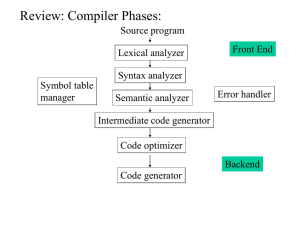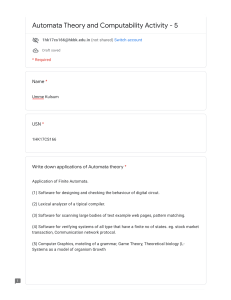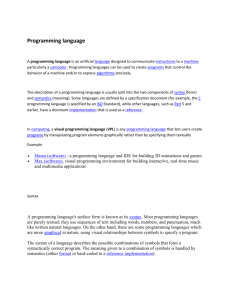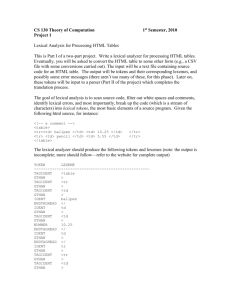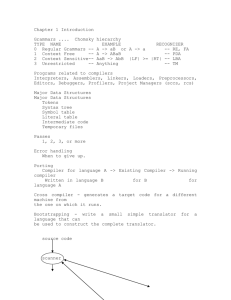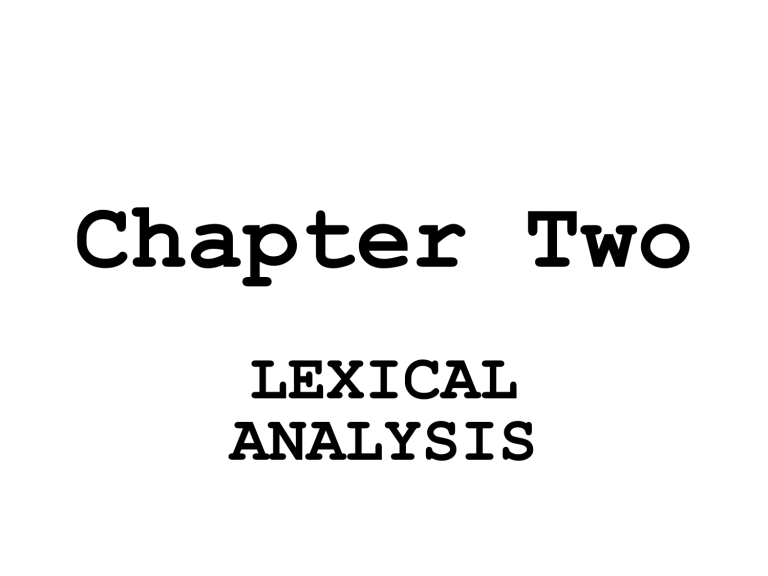
Chapter Two
LEXICAL
ANALYSIS
2.1. Introduction
• Lexical analysis is the first phase of a compiler. It
takes the modified source code from language
preprocessors that are written in the form of
sentences.
• The lexical analyzer breaks these sentences into a
series of tokens, by removing any whitespace or
comments in the source code. If the lexical analyzer
finds a token as invalid, it generates an error.
• The lexical analyzer works closely with the syntax
analyzer. It reads character streams from the source
code, checks for legal tokens, and passes the data to
the syntax analyzer when it demands.
Cont…
Figure 2.1 Working principle of Lexical Analyzer
2.2 Tokens
• Lexemes are said to be a sequence of characters
(alphanumeric) which is also called as tokens.
There are some predefined rules for every lexeme
to be identified as a valid token.
• These rules are defined by grammar rules, by
means of a pattern. A pattern explains what can be
a token, and these patterns are defined by means of
regular expressions.
Cont…
• In programming language, keywords, constants,
identifiers, strings, numbers, operators, and
punctuations symbols can be considered as tokens.
• For example, in C language, the variable declaration
line int value = 100; Contains the tokens:
• 1) int (keyword)
• 2) value (identifier)
• 3) = (operator)
• 4) 100 (constant)
• 5) ; (symbol)
Cont…
• 2.2.1 Specifications of Tokens
• Let us understand how the language theory
considers the following terms:
• 2.2.1.1 Alphabets
• Any finite set of symbols {0,1} is a set of binary
alphabets, {0,1,2,3,4,5,6,7,8,9,A,B,C,D,E,F} is a
set of Hexadecimal alphabets, {a-z, A-Z} is a set
of English language alphabets.
Cont…
• 2.2.1.2 Strings
• Any finite sequence of alphabets is called a string.
Length of the string is the total number of
alphabets in the string, e.g., the string S is
“INDIA”, the length of the string, S is 5 and is
denoted by |S|= 5.
• A string having no alphabets, i.e. a string of zero
length is known as an empty string and is denoted
by ε (epsilon).
Cont…
• 2.2.1.3 Special Symbols
• A typical high-level language contains the
following symbols:-
2.3 Language
• A language is considered as a finite set of strings
over some finite set of alphabets. Computer
languages are considered as finite sets, and
mathematically set operations can be performed on
them.
• Finite languages can be described by means of
regular expressions.
2.4 The role of Lexical Analysis
• 1. It could be a separate pass, placing its output on
an intermediate file from which the parser would
then take its input.
• 2. The lexical analyzer and parser are together in
the same pass; the lexical analyzer acts as a
subroutine or co routine, which is called by the
parser whenever it needs new token.
• 3. Eliminates the need for the intermediate file.
• 4. Returns a representation for the token it has
found to the parser.
Cont…
• Example: a (op) b i. Treats the op as the token. ii. Checks
whether the operator found is +, -, *, &,etc…
• 2.4.1 The need for lexical analysis
• The purpose of splitting the analysis into lexical analysis
and syntactic analysis are,
• To simplify the overall design.
• To specify the structure of tokens that is the syntactic
structure of the program easily.
• To construct more efficient recognizer for tokens than for
syntactic structure.
• 2.4.2 Input Buffering
• The lexical analyzer scans the characters of the source
program one at a time to discover token.
Cont…
Figure 2.2 Input Buffering
Cont…
• 2.4.3 Preliminary Scanning
• There are certain process that are best performed
as characters are moved from the source file to the
buffer.
• For example delete comments, ignore blanks,
etc… All these processes may be carried out with
an extra buffer.
2.5 Regular Expressions
• The lexical analyzer needs to scan and identify only a
finite set of valid string/token/lexeme that belong to
the language in hand. It searches for the pattern
defined by the language rules.
• Regular expressions have the capability to express
finite languages by defining a pattern for finite strings
of symbols. The grammar defined by regular
expressions is known as Regular Grammar.
• The language defined by regular grammar is known
as Regular Language. Regular expression is an
important notation for specifying patterns.
Cont…
• Each pattern matches a set of strings, so regular
expressions serve as names for a set of strings.
Programming language tokens can be described by
regular languages. The specification of regular
expressions is an example of a recursive
definition. Regular languages are easy to
understand and have efficient implementation.
• There are a number of algebraic laws that are
obeyed by regular expressions, which can be used
to manipulate regular expressions into equivalent
forms.
Cont…
• 2.5.1 Operations
• The various operations on languages are:
• 1. Union of two languages L and M is written as L
U M = {s | s is in L or s is in M}
• 2. Concatenation of two languages L and M is
written as LM = {st | s is in L and t is in M}
• 3. The Kleene Closure of a language L is written
as L* = Zero or more occurrence of language L.
Cont…
• 2.5.2 Notations
• If r and s are regular expressions denoting the
languages L(r) and L(s), then
• Union : (r)|(s) is a regular expression denoting L(r)
U L(s)
• Concatenation : (r)(s) is a regular expression
denoting L(r)L(s)
• Kleene closure : (r)* is a regular expression
denoting (L(r))*
• Note: (r) is a regular expression denoting L(r)
Cont…
• 2.5.3 Precedence and Associativity
• a) (Closure), concatenation (.), and | (pipe sign) are left
associative
• b) Closure has the highest precedence
• c) Concatenation (.) has the second highest precedence.
• d) | (pipe sign) has the lowest precedence of all.
• For any regular expressions R, S & T the following axioms
hold:
• i. R|S = S|R (| is commutative)
• ii. R | (S|T) = (R|S) | T (| is associative)
• iii. R(ST) = (RS)T ( is associative)
• iv. R(S | T) = RS | RT & (S | T)R = SR | TR ( is distributive
over |).
• v. R = R = R ( is the identity for concentration).
Cont…
• 2.5.4 Representing valid tokens of a language in
regular expression
• If X is a regular expression, then:
• 1) X* means zero or more occurrence of x. i.e., it can
generate { e, x, xx, xxx, xxxx, … }
• 2) X+ means one or more occurrence of X. i.e., it can
generate { x, xx, xxx, xxxx … } or x.x*
• 3) x? Means at most one occurrence of x.
• 4) [a-z] is all lower-case alphabets of English
language. [A-Z] is all upper-case alphabets of English
language. [0-9] is all natural digits used in
mathematics.
Cont…
• 2.5.4.1 Representing occurrence of symbols using
regular expressions
• a) Letter = [a – z] or [A – Z].
• b) Digit = 0 | 1 | 2 | 3 | 4 | 5 | 6 | 7 | 8 | 9 or [0-9]
sign = [ + | - ].
Cont…
• 2.5.4.2 Representing language tokens using
regular expressions
• 1) Decimal = (sign)?(digit)+
• 2) Identifier = (letter)(letter | digit)*
• The only problem left with the lexical analyzer is
how to verify the validity of a regular expression
used in specifying the patterns of keywords of a
language. A well-accepted solution is to use finite
automata for verification.
Reading Assignment…
•Regular Expression in
Detail
•Automata – DFA and NFA
in Detail

